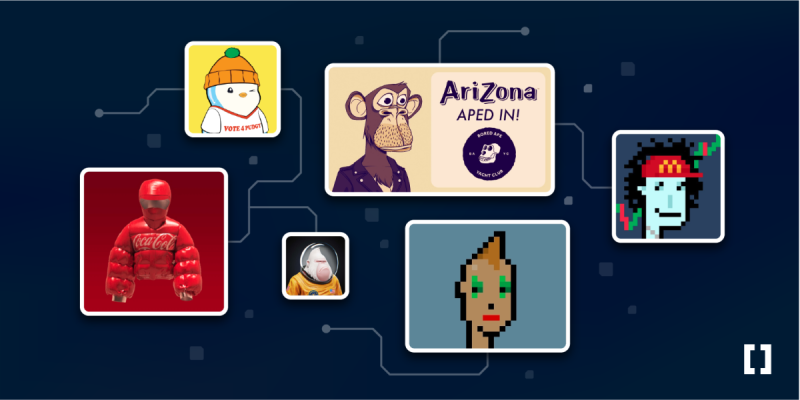With the world of crypto taking over global headlines, brands are no stranger to the potential of cryptocurrency as a platform for consumer engagement. In particular, NFTS, or non-fungible tokens, are swiftly entering marketing spaces. An NFT is a digital object representing tangible and intangible items, from artworks to even tweets. Brands have used NFTs to launch exclusive collections, forge unique experiences and reward customers. Undeniably, NFTs have become a force driving new-edge marketing campaigns today.
The main appeal surrounding NFTs is exclusivity. Think the Willy Wonka Golden Ticket coming to life. As each NFT is unique, buyers get exclusive ownership rights documented on the blockchain. This means the NFT cannot be traded for other equivalents and only belongs to the buyer throughout ownership.
The excitement is not only limited to the digital world. Owning an NFT can also unlock coveted offline experiences. One example is Hong Kong-based luxury marketplace Wear, that uses NFT memberships to give members access to exclusive product drops and fashion events.
Many Singapore brands recognise the value of NFTs to reward customer loyalty and build a community. For instance, the Ice Cream & Cookie Co. is set to launch its app with an NFT-based membership system, where members can collect ingredient cards and get first-hand access to new ice cream flavours. NFT marketing is also on the go, literally. Singapore carpooling service Ryde recently launched RydePal NFTs, giving riders extra discounts and priority bookings in the long run.

Furthermore, brands can seamlessly integrate NFT marketing with existing consumer engagement efforts. For example, Clinique opened up NFT access to loyalty programme members, incentivising sign-ups. With access to third-party data decreasing, loyalty programmes are at the forefront of brand priorities, and NFTs can help facilitate this process.
NFTs present an opportunity to drive brand awareness and elevate traditional membership models for brands. But, most importantly, it builds a community of consumers that feel like they have a stake in the brand, building long-term brand loyalty.
With brands looking for new ways to reinvent themselves, many see NFTs as a quick fix. However, brands should tread this space with caution. The recent collapse of Luna and TerraUSD, two major cryptocurrencies, demonstrates how unpredictable the market is. Furthermore, owning an exclusive product is not an immediate priority for the public. As a result, brands could face potential criticism, especially when NFTs do not align with their core business values. In addition, cryptocurrency has been criticised for its large energy consumption and carbon footprint. One example is MeUndies, which received backlash for working with NFTs despite promoting sustainability in their products. This shining facade could easily backfire if brands solely fixate on pushing NFT sales.

Here are some suggestions on NFT marketing applications that brands should be aware of before venturing into this space.
1. Analyse consumer needs
Understanding consumer demographics is the foundation of a strong marketing campaign. For luxury brands, their consumers are familiar with cryptocurrency and might have an existing stake in the NFT space. However, other brands should carefully analyse how they can democratise NFTs without alienating their core customer.
Furthermore, consumers can be further categorised based on their level of spending. NFTs can be divided into different price points, allowing brands to introduce NFT-physical product pairs. This enables brands to customise their marketing efforts instead of forcing a one-size-fits-all campaign approach.
2. Identify how your campaign will use NFTs
Start by identifying a gap in existing marketing efforts. NFTs can facilitate community creation, allowing brands to move away from top-down approaches via reward programmes.
NFT giveaways can generate social media attention for your brand. One example is Hugo Boss' Tik Tok challenge which allowed users to win five unique Boss NFT jackets and a physical twin. The hashtag generated more than 7.5 billion views and positioned Hugo Boss as a tech-driven fashion platform.
Want the whole town to talk about your brand? NFTs are a bold and innovative way to generate hype for events. Try NFT giveaways or give consumers the chance to create their own NFT.

3. Merging offline and online experiences
While NFTs are only in the online metaverse, marketers should not shy away from offline campaign touchpoints as they can seamlessly integrate in-person experiences for a cohesive marketing strategy. For example, brands can complement offline product launches with NFT giveaways to drive physical footfall to stores and reward loyal customers.
4. Potential for B2B brands
NFTs are not only for consumer-facing brands as they can help B2B brands strengthen brand awareness in a crowded digital space. For example, NFTS can be used as early access tokens for product and service launches. Moreover, having ownership and a stake in the brand begins long-lasting relationships between brands. One example is Shopify, which added NFT-Gated options for online retailers. This feature allows retailers to add crypto wallets as a payment option and rollout NFTs on their platform. For Shopify, it enables them to reach a broader target audience and stand out from other e-commerce platforms. Hence, there is significant value for B2B brands.
